Literature Review: Interventions for Surgical Site Infections
VerifiedAdded on 2023/04/21
|6
|1343
|83
Literature Review
AI Summary
This literature review examines surgical site infections (SSIs) and potential interventions, focusing on the effectiveness of chlorhexidine baths compared to regular soap and water. The review analyzes six peer-reviewed journals, comparing research questions, sample populations, and limitations. Key studies explore the impact of SSIs on healthcare costs and quality of life, the detection of post-ambulatory surgery infections, the association between diabetes and SSIs, and factors commonly linked to SSIs. The review highlights the importance of perioperative care and counseling for high-risk patients, as well as the validation of risk-based models in SSI management. While acknowledging limitations such as small or outdated sample sizes, the review concludes that these studies provide valuable insights into the causes, impact, and interventions for SSIs, recommending further research to minimize risks and improve patient outcomes. Desklib offers a wide range of academic resources, including past papers and solved assignments, to support students in their studies.
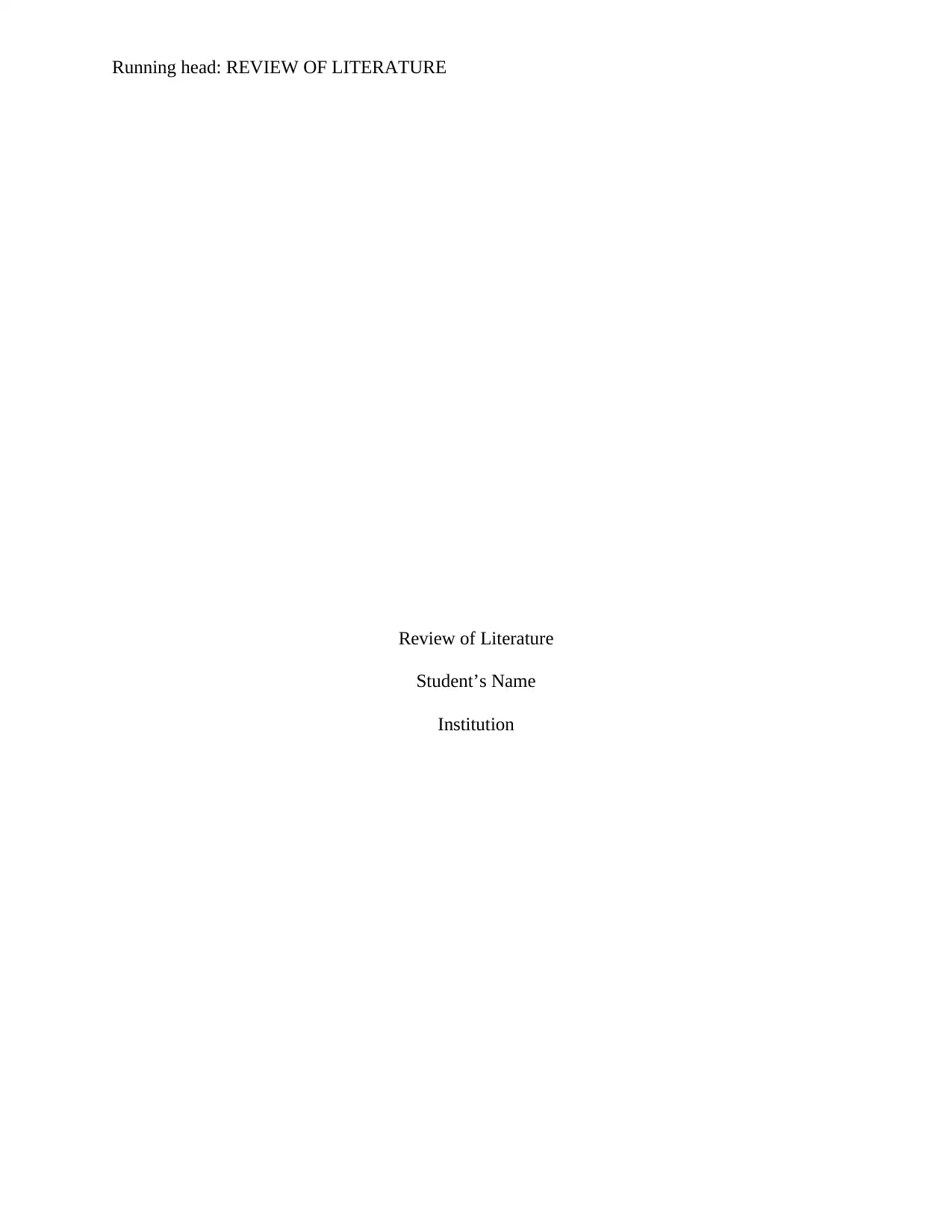
Running head: REVIEW OF LITERATURE
Review of Literature
Student’s Name
Institution
Review of Literature
Student’s Name
Institution
Paraphrase This Document
Need a fresh take? Get an instant paraphrase of this document with our AI Paraphraser
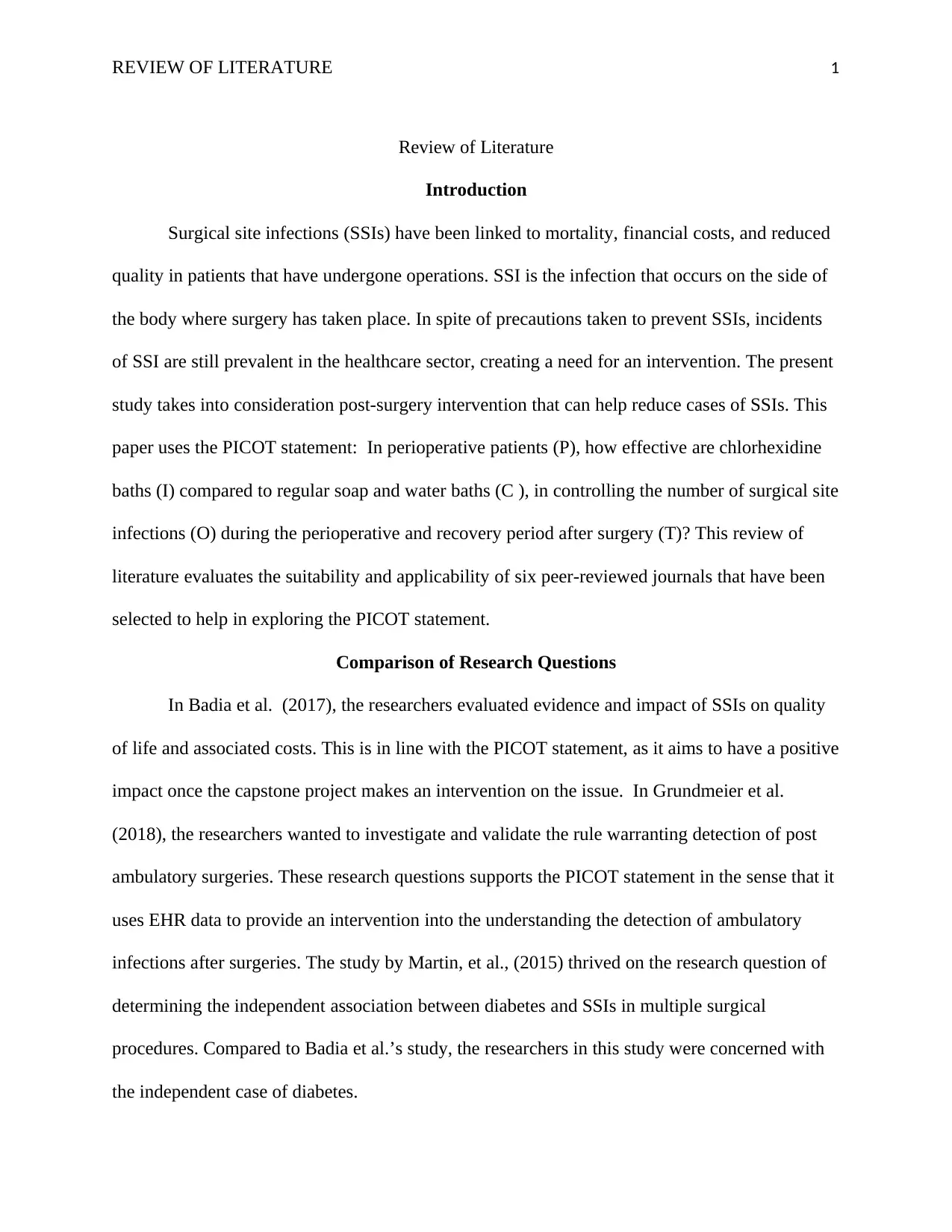
REVIEW OF LITERATURE 1
Review of Literature
Introduction
Surgical site infections (SSIs) have been linked to mortality, financial costs, and reduced
quality in patients that have undergone operations. SSI is the infection that occurs on the side of
the body where surgery has taken place. In spite of precautions taken to prevent SSIs, incidents
of SSI are still prevalent in the healthcare sector, creating a need for an intervention. The present
study takes into consideration post-surgery intervention that can help reduce cases of SSIs. This
paper uses the PICOT statement: In perioperative patients (P), how effective are chlorhexidine
baths (I) compared to regular soap and water baths (C ), in controlling the number of surgical site
infections (O) during the perioperative and recovery period after surgery (T)? This review of
literature evaluates the suitability and applicability of six peer-reviewed journals that have been
selected to help in exploring the PICOT statement.
Comparison of Research Questions
In Badia et al. (2017), the researchers evaluated evidence and impact of SSIs on quality
of life and associated costs. This is in line with the PICOT statement, as it aims to have a positive
impact once the capstone project makes an intervention on the issue. In Grundmeier et al.
(2018), the researchers wanted to investigate and validate the rule warranting detection of post
ambulatory surgeries. These research questions supports the PICOT statement in the sense that it
uses EHR data to provide an intervention into the understanding the detection of ambulatory
infections after surgeries. The study by Martin, et al., (2015) thrived on the research question of
determining the independent association between diabetes and SSIs in multiple surgical
procedures. Compared to Badia et al.’s study, the researchers in this study were concerned with
the independent case of diabetes.
Review of Literature
Introduction
Surgical site infections (SSIs) have been linked to mortality, financial costs, and reduced
quality in patients that have undergone operations. SSI is the infection that occurs on the side of
the body where surgery has taken place. In spite of precautions taken to prevent SSIs, incidents
of SSI are still prevalent in the healthcare sector, creating a need for an intervention. The present
study takes into consideration post-surgery intervention that can help reduce cases of SSIs. This
paper uses the PICOT statement: In perioperative patients (P), how effective are chlorhexidine
baths (I) compared to regular soap and water baths (C ), in controlling the number of surgical site
infections (O) during the perioperative and recovery period after surgery (T)? This review of
literature evaluates the suitability and applicability of six peer-reviewed journals that have been
selected to help in exploring the PICOT statement.
Comparison of Research Questions
In Badia et al. (2017), the researchers evaluated evidence and impact of SSIs on quality
of life and associated costs. This is in line with the PICOT statement, as it aims to have a positive
impact once the capstone project makes an intervention on the issue. In Grundmeier et al.
(2018), the researchers wanted to investigate and validate the rule warranting detection of post
ambulatory surgeries. These research questions supports the PICOT statement in the sense that it
uses EHR data to provide an intervention into the understanding the detection of ambulatory
infections after surgeries. The study by Martin, et al., (2015) thrived on the research question of
determining the independent association between diabetes and SSIs in multiple surgical
procedures. Compared to Badia et al.’s study, the researchers in this study were concerned with
the independent case of diabetes.
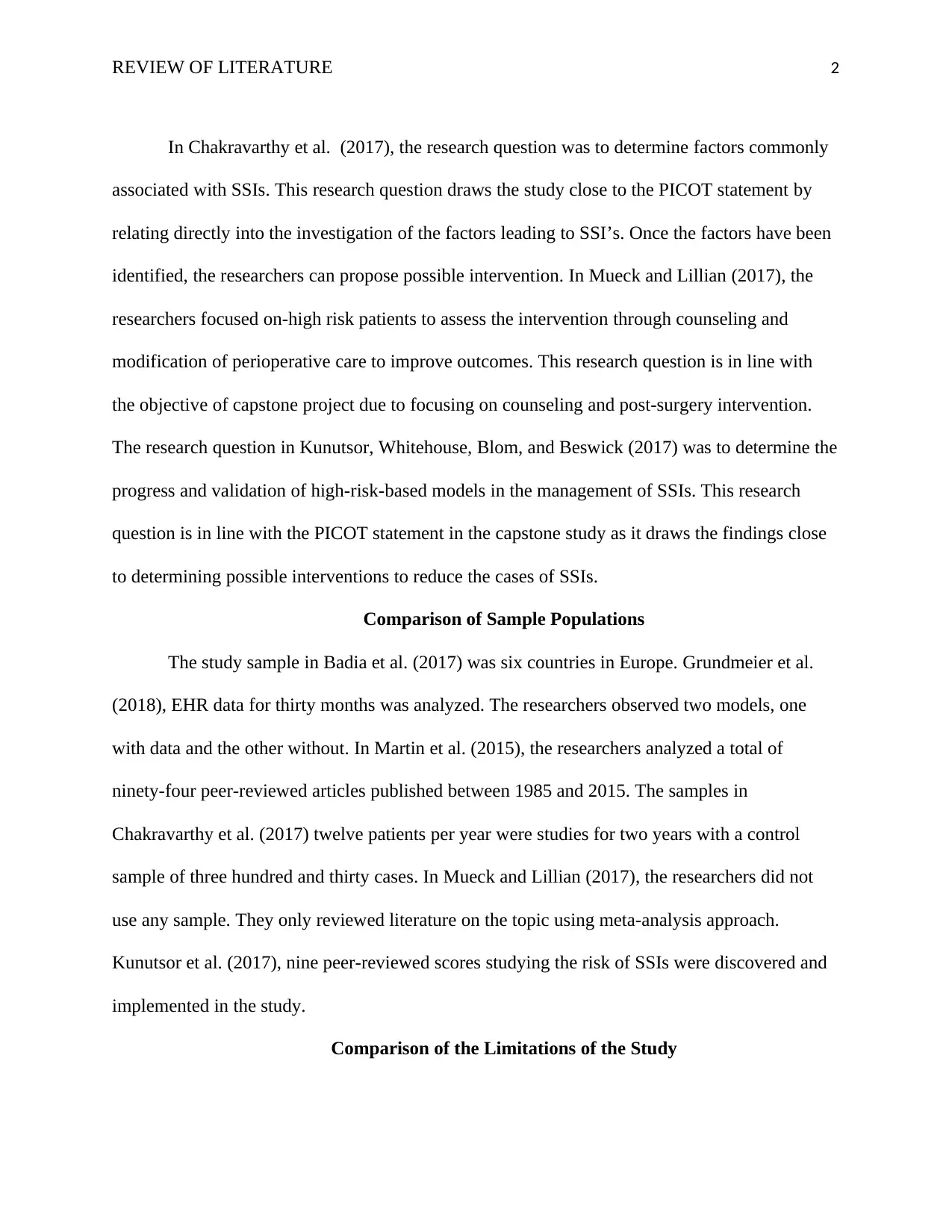
REVIEW OF LITERATURE 2
In Chakravarthy et al. (2017), the research question was to determine factors commonly
associated with SSIs. This research question draws the study close to the PICOT statement by
relating directly into the investigation of the factors leading to SSI’s. Once the factors have been
identified, the researchers can propose possible intervention. In Mueck and Lillian (2017), the
researchers focused on-high risk patients to assess the intervention through counseling and
modification of perioperative care to improve outcomes. This research question is in line with
the objective of capstone project due to focusing on counseling and post-surgery intervention.
The research question in Kunutsor, Whitehouse, Blom, and Beswick (2017) was to determine the
progress and validation of high-risk-based models in the management of SSIs. This research
question is in line with the PICOT statement in the capstone study as it draws the findings close
to determining possible interventions to reduce the cases of SSIs.
Comparison of Sample Populations
The study sample in Badia et al. (2017) was six countries in Europe. Grundmeier et al.
(2018), EHR data for thirty months was analyzed. The researchers observed two models, one
with data and the other without. In Martin et al. (2015), the researchers analyzed a total of
ninety-four peer-reviewed articles published between 1985 and 2015. The samples in
Chakravarthy et al. (2017) twelve patients per year were studies for two years with a control
sample of three hundred and thirty cases. In Mueck and Lillian (2017), the researchers did not
use any sample. They only reviewed literature on the topic using meta-analysis approach.
Kunutsor et al. (2017), nine peer-reviewed scores studying the risk of SSIs were discovered and
implemented in the study.
Comparison of the Limitations of the Study
In Chakravarthy et al. (2017), the research question was to determine factors commonly
associated with SSIs. This research question draws the study close to the PICOT statement by
relating directly into the investigation of the factors leading to SSI’s. Once the factors have been
identified, the researchers can propose possible intervention. In Mueck and Lillian (2017), the
researchers focused on-high risk patients to assess the intervention through counseling and
modification of perioperative care to improve outcomes. This research question is in line with
the objective of capstone project due to focusing on counseling and post-surgery intervention.
The research question in Kunutsor, Whitehouse, Blom, and Beswick (2017) was to determine the
progress and validation of high-risk-based models in the management of SSIs. This research
question is in line with the PICOT statement in the capstone study as it draws the findings close
to determining possible interventions to reduce the cases of SSIs.
Comparison of Sample Populations
The study sample in Badia et al. (2017) was six countries in Europe. Grundmeier et al.
(2018), EHR data for thirty months was analyzed. The researchers observed two models, one
with data and the other without. In Martin et al. (2015), the researchers analyzed a total of
ninety-four peer-reviewed articles published between 1985 and 2015. The samples in
Chakravarthy et al. (2017) twelve patients per year were studies for two years with a control
sample of three hundred and thirty cases. In Mueck and Lillian (2017), the researchers did not
use any sample. They only reviewed literature on the topic using meta-analysis approach.
Kunutsor et al. (2017), nine peer-reviewed scores studying the risk of SSIs were discovered and
implemented in the study.
Comparison of the Limitations of the Study
⊘ This is a preview!⊘
Do you want full access?
Subscribe today to unlock all pages.

Trusted by 1+ million students worldwide
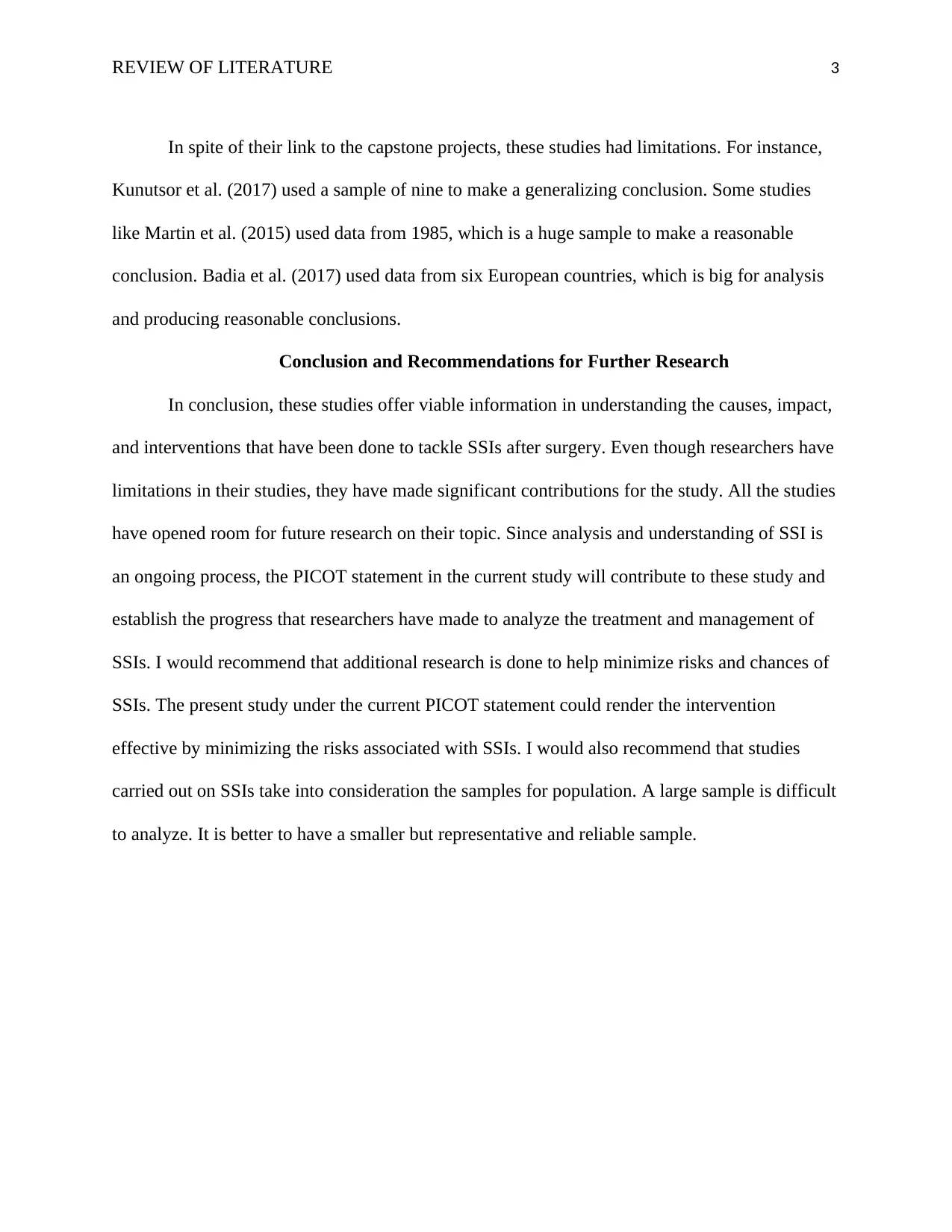
REVIEW OF LITERATURE 3
In spite of their link to the capstone projects, these studies had limitations. For instance,
Kunutsor et al. (2017) used a sample of nine to make a generalizing conclusion. Some studies
like Martin et al. (2015) used data from 1985, which is a huge sample to make a reasonable
conclusion. Badia et al. (2017) used data from six European countries, which is big for analysis
and producing reasonable conclusions.
Conclusion and Recommendations for Further Research
In conclusion, these studies offer viable information in understanding the causes, impact,
and interventions that have been done to tackle SSIs after surgery. Even though researchers have
limitations in their studies, they have made significant contributions for the study. All the studies
have opened room for future research on their topic. Since analysis and understanding of SSI is
an ongoing process, the PICOT statement in the current study will contribute to these study and
establish the progress that researchers have made to analyze the treatment and management of
SSIs. I would recommend that additional research is done to help minimize risks and chances of
SSIs. The present study under the current PICOT statement could render the intervention
effective by minimizing the risks associated with SSIs. I would also recommend that studies
carried out on SSIs take into consideration the samples for population. A large sample is difficult
to analyze. It is better to have a smaller but representative and reliable sample.
In spite of their link to the capstone projects, these studies had limitations. For instance,
Kunutsor et al. (2017) used a sample of nine to make a generalizing conclusion. Some studies
like Martin et al. (2015) used data from 1985, which is a huge sample to make a reasonable
conclusion. Badia et al. (2017) used data from six European countries, which is big for analysis
and producing reasonable conclusions.
Conclusion and Recommendations for Further Research
In conclusion, these studies offer viable information in understanding the causes, impact,
and interventions that have been done to tackle SSIs after surgery. Even though researchers have
limitations in their studies, they have made significant contributions for the study. All the studies
have opened room for future research on their topic. Since analysis and understanding of SSI is
an ongoing process, the PICOT statement in the current study will contribute to these study and
establish the progress that researchers have made to analyze the treatment and management of
SSIs. I would recommend that additional research is done to help minimize risks and chances of
SSIs. The present study under the current PICOT statement could render the intervention
effective by minimizing the risks associated with SSIs. I would also recommend that studies
carried out on SSIs take into consideration the samples for population. A large sample is difficult
to analyze. It is better to have a smaller but representative and reliable sample.
Paraphrase This Document
Need a fresh take? Get an instant paraphrase of this document with our AI Paraphraser
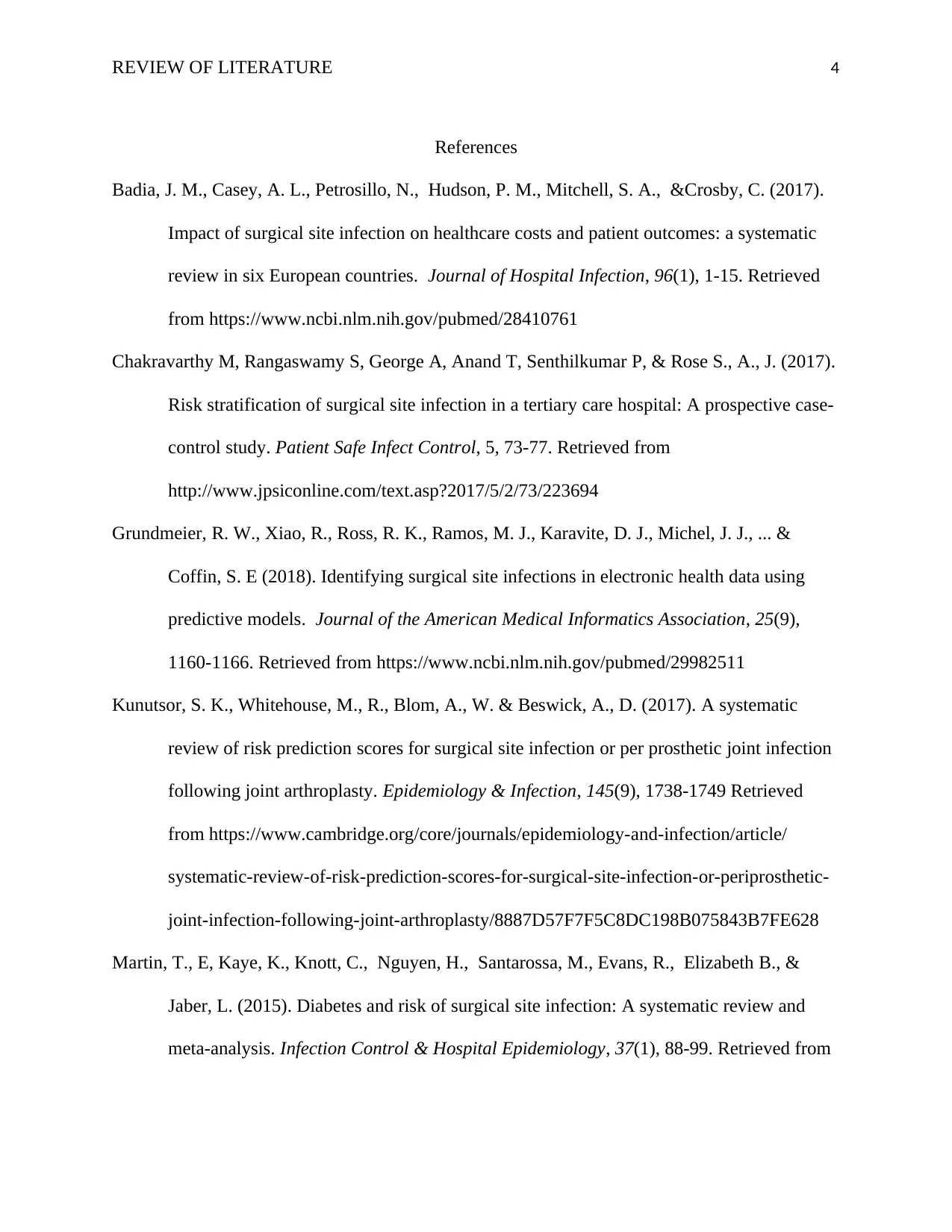
REVIEW OF LITERATURE 4
References
Badia, J. M., Casey, A. L., Petrosillo, N., Hudson, P. M., Mitchell, S. A., &Crosby, C. (2017).
Impact of surgical site infection on healthcare costs and patient outcomes: a systematic
review in six European countries. Journal of Hospital Infection, 96(1), 1-15. Retrieved
from https://www.ncbi.nlm.nih.gov/pubmed/28410761
Chakravarthy M, Rangaswamy S, George A, Anand T, Senthilkumar P, & Rose S., A., J. (2017).
Risk stratification of surgical site infection in a tertiary care hospital: A prospective case-
control study. Patient Safe Infect Control, 5, 73-77. Retrieved from
http://www.jpsiconline.com/text.asp?2017/5/2/73/223694
Grundmeier, R. W., Xiao, R., Ross, R. K., Ramos, M. J., Karavite, D. J., Michel, J. J., ... &
Coffin, S. E (2018). Identifying surgical site infections in electronic health data using
predictive models. Journal of the American Medical Informatics Association, 25(9),
1160-1166. Retrieved from https://www.ncbi.nlm.nih.gov/pubmed/29982511
Kunutsor, S. K., Whitehouse, M., R., Blom, A., W. & Beswick, A., D. (2017). A systematic
review of risk prediction scores for surgical site infection or per prosthetic joint infection
following joint arthroplasty. Epidemiology & Infection, 145(9), 1738-1749 Retrieved
from https://www.cambridge.org/core/journals/epidemiology-and-infection/article/
systematic-review-of-risk-prediction-scores-for-surgical-site-infection-or-periprosthetic-
joint-infection-following-joint-arthroplasty/8887D57F7F5C8DC198B075843B7FE628
Martin, T., E, Kaye, K., Knott, C., Nguyen, H., Santarossa, M., Evans, R., Elizabeth B., &
Jaber, L. (2015). Diabetes and risk of surgical site infection: A systematic review and
meta-analysis. Infection Control & Hospital Epidemiology, 37(1), 88-99. Retrieved from
References
Badia, J. M., Casey, A. L., Petrosillo, N., Hudson, P. M., Mitchell, S. A., &Crosby, C. (2017).
Impact of surgical site infection on healthcare costs and patient outcomes: a systematic
review in six European countries. Journal of Hospital Infection, 96(1), 1-15. Retrieved
from https://www.ncbi.nlm.nih.gov/pubmed/28410761
Chakravarthy M, Rangaswamy S, George A, Anand T, Senthilkumar P, & Rose S., A., J. (2017).
Risk stratification of surgical site infection in a tertiary care hospital: A prospective case-
control study. Patient Safe Infect Control, 5, 73-77. Retrieved from
http://www.jpsiconline.com/text.asp?2017/5/2/73/223694
Grundmeier, R. W., Xiao, R., Ross, R. K., Ramos, M. J., Karavite, D. J., Michel, J. J., ... &
Coffin, S. E (2018). Identifying surgical site infections in electronic health data using
predictive models. Journal of the American Medical Informatics Association, 25(9),
1160-1166. Retrieved from https://www.ncbi.nlm.nih.gov/pubmed/29982511
Kunutsor, S. K., Whitehouse, M., R., Blom, A., W. & Beswick, A., D. (2017). A systematic
review of risk prediction scores for surgical site infection or per prosthetic joint infection
following joint arthroplasty. Epidemiology & Infection, 145(9), 1738-1749 Retrieved
from https://www.cambridge.org/core/journals/epidemiology-and-infection/article/
systematic-review-of-risk-prediction-scores-for-surgical-site-infection-or-periprosthetic-
joint-infection-following-joint-arthroplasty/8887D57F7F5C8DC198B075843B7FE628
Martin, T., E, Kaye, K., Knott, C., Nguyen, H., Santarossa, M., Evans, R., Elizabeth B., &
Jaber, L. (2015). Diabetes and risk of surgical site infection: A systematic review and
meta-analysis. Infection Control & Hospital Epidemiology, 37(1), 88-99. Retrieved from
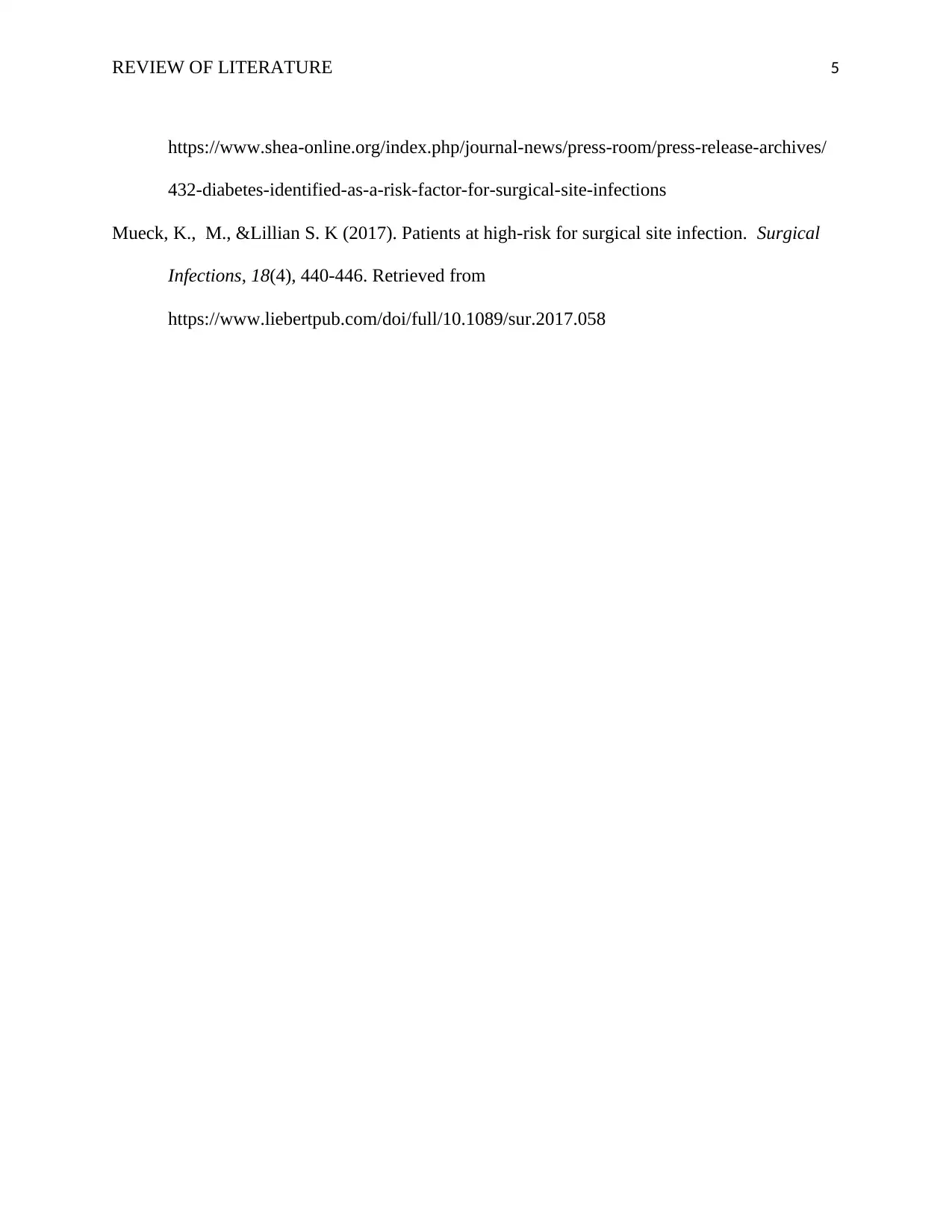
REVIEW OF LITERATURE 5
https://www.shea-online.org/index.php/journal-news/press-room/press-release-archives/
432-diabetes-identified-as-a-risk-factor-for-surgical-site-infections
Mueck, K., M., &Lillian S. K (2017). Patients at high-risk for surgical site infection. Surgical
Infections, 18(4), 440-446. Retrieved from
https://www.liebertpub.com/doi/full/10.1089/sur.2017.058
https://www.shea-online.org/index.php/journal-news/press-room/press-release-archives/
432-diabetes-identified-as-a-risk-factor-for-surgical-site-infections
Mueck, K., M., &Lillian S. K (2017). Patients at high-risk for surgical site infection. Surgical
Infections, 18(4), 440-446. Retrieved from
https://www.liebertpub.com/doi/full/10.1089/sur.2017.058
⊘ This is a preview!⊘
Do you want full access?
Subscribe today to unlock all pages.

Trusted by 1+ million students worldwide
1 out of 6
Related Documents
Your All-in-One AI-Powered Toolkit for Academic Success.
+13062052269
info@desklib.com
Available 24*7 on WhatsApp / Email
![[object Object]](/_next/static/media/star-bottom.7253800d.svg)
Unlock your academic potential
Copyright © 2020–2025 A2Z Services. All Rights Reserved. Developed and managed by ZUCOL.





